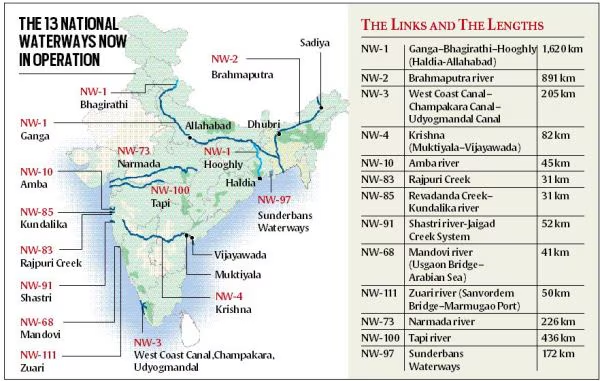Context
-
Recently, Parliament passed the Inland Vessels Bill 2021 that will bring uniformity in the rules and regulations governing inland waterways and navigation on them.
About the Inland Vessels Bill 2021
- It is aimed at developing India’s inland waterways as a viable, thriving mode of transport, especially for cargo.
- The inland waterways network spans close to 15,000 km across rivers, channels, backwaters, creeks etc.

- The Inland Vessels Bill, 2021 replaces the Inland Vessels Act, 1917.
- The Bill defines mechanically propelled vessels as ships, boats, sailing vessels, container vessels, and ferries.
- The Centre will frame classification, standards of design, construction, and crew accommodation.
- Construction or modification will require approval of a designated authority.
- All such vessels are to be registered with respective states or Union Territories. Their movement and identities will be logged in a central database.
- The new law mandates that if any distress or SOS signal is sent out by the master of a vessel, any other vessel nearby must respond — much like maritime custom and rules on sea. If the master of a nearby vessel fails to come for help, he or she will be fined up to Rs 10,000 unless they failed to provide assistance on some specified grounds.
- In case of accidents, the nearest police station is to be involved for inquiry and action.
- The Centre will prescribe the minimum number of people that vessels must carry for various roles, and what the qualification of the personnel must be. Non-compliance will attract a penalty of up to Rs 10,000 for the first offence, and Rs 25,000 for subsequent offences.
- The new law empowers the Centre to prescribe what kind of pollutants and sewage vessels and can discharge, and how much.
- The Bill envisages maintaining a fund, which will be used for emergency preparedness, checking pollution and boosting navigation.
- The fund will source from state governments schemes, sale of cargo and wreck and contribution from stakeholders.
Limitations of old law
- It seeks to bring all inland waterways in India and movement of vessels on them for any purpose under a central regulatory regime.
- The 1917 Act was seen as a purely consolidating legislation with limited applicability and purposes, the government said.
- It had undergone several amendments, the last major ones in 1977 and 2007.
- This Act had provisions for restrictive movement of mechanically propelled vessels within the jurisdiction of the state government, requirement of endorsements, limited applicability and validity of certificates, non-uniform standards and regulations that varied from one State to another led to hindrances and hurdles in seamless navigation across States and development of the sector.
National Waterways
- In 2016, the government notified 111 inland waterways as National Waterways of India under the National Waterways Act, 2016. Of these, 13 National Waterways are operational for shipping and navigation and cargo/passenger vessels are moving on them, according to the government (see graphic).
- The Inland Waterways Authority of India under the Ministry of Shipping is developing the National Waterways for commercial navigation, including with assistance from the World Bank.
- The government wants to promote inland waterways especially as a supplement to freight movement across India. This mode of transport has been recognised worldwide as environmentally friendly and economical, especially for cargo that do not depend on speed of delivery.
- According to a government study conducted by RITES, one litre of fuel moves 24 tonne-km on road; 95 tonne-km on rail and 215 tonne-km on inland waterways. To move a tonne of cargo over a kilometre, it takes about Rs 1.36 on railways, Rs 2.50 on highways, and Rs 1.06 on inland waterways.
- Underutilised right now, India’s inland waterways carry about 55 million tonnes of cargo every year. The movement is currently restricted to Ganga-Bhagirathi-Hooghly, Brahmaputra, Barak, rivers in Goa, the backwaters in Kerala, inland waters in Mumbai and deltaic regions of Godavari-Krishna rivers.
Criticism of Inland Vessels Bill 2021
- It takes away a lot of rights of the states and vests them with the Centre.
- The new law prescribes certain dos and don’ts. For example, to operate in inland waters, vessels must have a certificate of survey, and registration.
- Those with Indian ownership must be registered with the Registrar of Inland Vessels (appointed by the state government). Once registered, it will be valid across India.
- While the state government will issue the certificate, the form will be prescribed by the Centre, much like in the case of motor vehicles. Like motor vehicles, the vessels must be insured.
- Mechanical vessels must adhere to specifications for signals and equipment to ensure navigation safety, as specified by the central government.
Economy Current Affairs 2021 : Click Here
